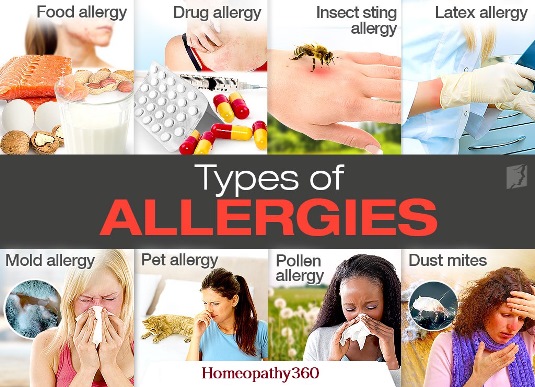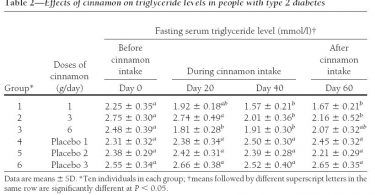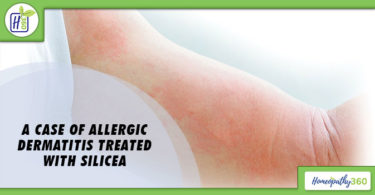Allergy is an abnormal individual hypersensitivity to substances that are ordinarily harmless to others. For e.g.-the pollen of plants is generally harmless yet many people are actually sensitive to its presence in the atmosphere .The hyper and abnormally sensitive state of a person is called allergy. It commonly affects the respiratory passages and the skin, although other areas such as the digestive tract, nervous system, joints, kidneys and blood vessels may also be affected.

TYPES: There are two types of allergies exogenic or external and endogenic or internal.
exogenous allergy is caused by any of the various allergens mentioned erroneously. Every allergy is taken as exogenous and there fore various tests such as patch test on the skin are done and the patient is finally advised to avoid scores of things to which he shows sensitivity .This is impractical because of busy modern life, especially in the cities. It is necessary to avoid only those allergens which are detected positive in various tests; they are liable to produce anaphylaxis which can be fatal.
Dr. Samuel Hahnemann in his Organon 5th edition aphorism 117 has called it idiosyncrasy and gives the example “some persons are apt to faint from the smell of roses”. The agent provoking an allergic reaction is called an allergy. The most common allergens are pollens, animal hair, foods, drugs and contact allergens. Allergies commonly affect the respiratory passages and the skin, although other areas as the digestive tract, nervous system joints kidneys and blood vessels may also involved.
endogenous allergy on other hand is caused by those factors which are present inside the body. It has varied symptoms.
Pathology of Allergy: Allergy or Anaphylaxis is defined as a state of rapidly developing immune response to an antigen to which the individual is previously sensitised. The response is mediated by humoral antibodies of IgE type. IgE antibodies sensitize basophils of peripheral blood or mast cells of tissues leading to release of pharmacologically-active substances called anaphylactic mediators. These substances are histamine, serotonin, vasoactive intestinal peptide, platelet activating factor and prostaglandins.
The effects of these agents are:
– Increased vascular permeability.
– Smooth muscle contraction.
– Early vasoconstriction followed by vasodilatation.
– Shock.
– Increased nasal and lacrimal secretion; and
– Increased gastric secretion.
Some of the forms in which allergy is most commonly seen in clinical practice are:
URTICARIA:-Urticaria or hives are itchy, burning swellings that appear on the skin as an indication of an allergic sensitivity to various foods or as a response to an invading organism either parasitic or bacterial.
The development of Urticaria occurs when the body releases histamine into the blood stream or tissues as an allergic response, causing widening of capillaries and escape of plasma through their walls, producing swellings on the skin. The condition is usually triggered by foods such as strawberries, peaches, nuts, shellfish, pork and some wheat products, surface irritants such as feathers, wool and animal furs, cosmetics containing chemical dyes, serums in the form of immunizing vaccines, insect bites, chiefly penicillin and some of the medicines prescribed for hypertension Urticaria appears as red or white blotches on the skin accompanied by itching and burning .They may disappear as suddenly as they came or they may last for several days .
It may present in acute conditions as:
1. Severe itching usually precedes the outbreak.
2. Eruptions of various sizes suddenly appear.
3. In a few minutes eruptions may develop, spread and grow together into larger hives.
4. Any part of the body may be the site of outbreak.
5. May last for from few hours to several days
The most serious complication is the development of giant hives also known as angioneurotic edema. When this condition occurs in the all passages, breathing is totally obstructed by the internal swelling. Giant hives may also appear on the eyelids, the lips or the tongue. The patient should be given medicines along with preventive measures to avoid frequent attacks.
Hives can best be prevented by identifying the allergen and avoiding it. It may be detected by experience of repeatedly getting attacks ,as by eating certain specific items of foods or coming in contact with certain articles .People who know that they are allergic to particular medicines should never fail to inform nurses ,dentists and doctors of their sensitivity .Any one who has survived a severe allergic response to the sting of a bee or wasp should always have a few homoeopathic medicines with him and take according to symptoms immediately viz ,Acit-a, Apis-m ,Ars-a, Hyp-led. The common remedies required for the treatment are Antipyine, Apis-m, Ars-m, Ars-a, As-tacus, Bovista, Calc-c, Chloralium, cina, Copoiva, Dulca, Fago, Nux-v, Nat-m, Rhus-t, Sulph, Urt-u etc.
2.ACNE:-Acne is a disorder of the skin with eruptions of papules or pustules ,more particularly in Acne vulgaris .It occurs usually in adolescence with comedones (blackheads) papules nodules and pustules on the face ,neck and upper part of the trunk .
3. ECZEMA: – The term eczema is a Greek word, ‘Ec’ means out and ‘zeo’ means boil. This disease is cutaneous and allergic in nature first, there is superficial inflammation of the epidermis. Then there is vesication which causes mild to severe itching .the development of the disease is from erythema to papules with edema and vesicles (weeping-crusting-pustules-scaling-finally leaving skin without scars). Basically two factors combine to cause dermatitis and eczema first the endogenic (internal) one which renders the skin allergic or vulnerable and secondly the exogenic (external) invasion of an allergen by contact. Truly speaking “there is no eczema but an eczematous patient”. It needs to be emphasized that sensitiveness running in families is an important factor and there is usually a family history of allergy viz urticaria, allergic rhinitis, eczema or asthma. Most of the eczemas are not infection and they heal completely with out scarring unless a secondary infection occurs. For the treatment of eczema we commonly consider sulph, graphities, petrol, mezerium, rhus tox, oleand, crot-t, staphisagria, natrum sulph, ars-alb. antium crud, thuja, nux-vom, apis-mel, cantharis ,anacardium, vinca-m, kali-m, etc..
4.SINUSITIS:-This inflammation of one or more of the paranasal sinuses ,often occurs during an upper respiratory infection but it can also be due to some allergy. Treatment of sinusitis should be directed towards the cause of the disease through classic homoeopathic treatment.
5.ALLERGIC RHINITIS:-It occurs continuously or intermittently due to exposure to more or less ever present allergens marked by sudden attacks of sneezing ,swelling of the nasal mucus with profuse watery discharge ,itching of the eyes and lachrymation . It is also called non-seasonal or perennial hay fever .Commonly used remedies for this condition are-allium cepa ,gelsemium ,nux-vom, merc ,pulsatilla, ars alb. Camphora, nat-mur, sab. Etc..
6.BRONCHIAL ASTHMA;-Bronchial asthma is a condition of sudden paroxysmal dysponea accompanied by wheezing caused by hyperactivity of the vagus nerve endings in the bronchoconstrictor muscles resulting in bronchospasm .It is associated with hyperaemia of the mucus membranes followed by excessive broncho secretion .the bronchial narrowing interferes with pulmonary ventilation and dysponea results which is often intense and chiefly expiratory in character.
7.TONSILS AND ADENOID AFFECTION :-Tonsils are like two sentinels standing on either side of the pharynx in the middle of the throat and back of the nose .Both tonsils and adenoids serve to fight and collect micro organisms from entering the chest through the throat and in the process often get enlarged .It is an erroneous idea that their surgical removal decreases the individuals susceptibility to catch infection .Experience shows that such a drastic measure increases the susceptibility and the allergic patients suffer from allergy all the more ,specially in diseases like sinusitis ,allergic rhinitis and bronchial asthma ,remedies useful for tonsils are usually equally useful for adenoids also ,these include BAR-CARB, CAL-PHOS ,BELLODONNA ,HEPAR SULPH ,SILICEA , MERC, PHYTOLACCA, APIS MEL, LACHESIS, ETC…





